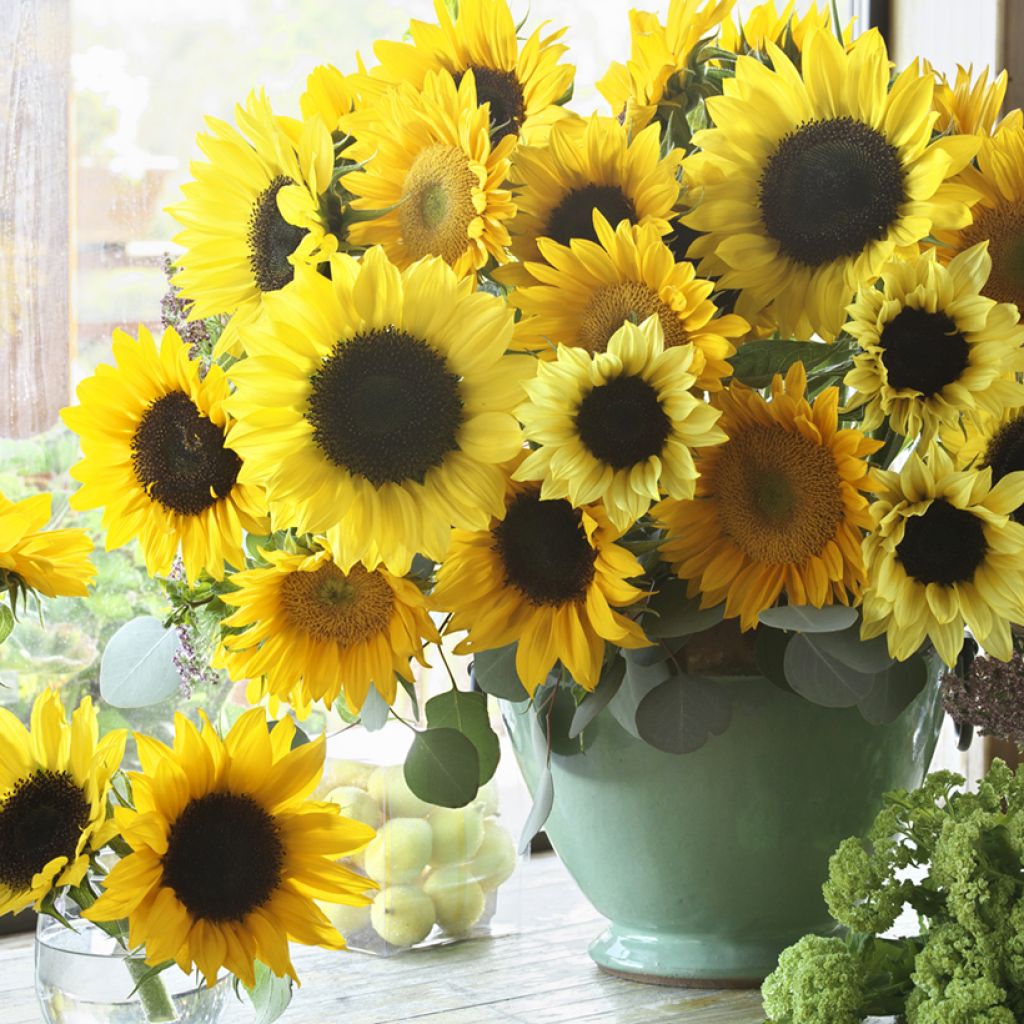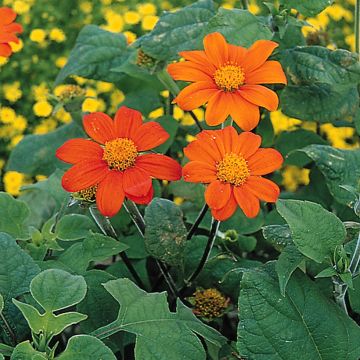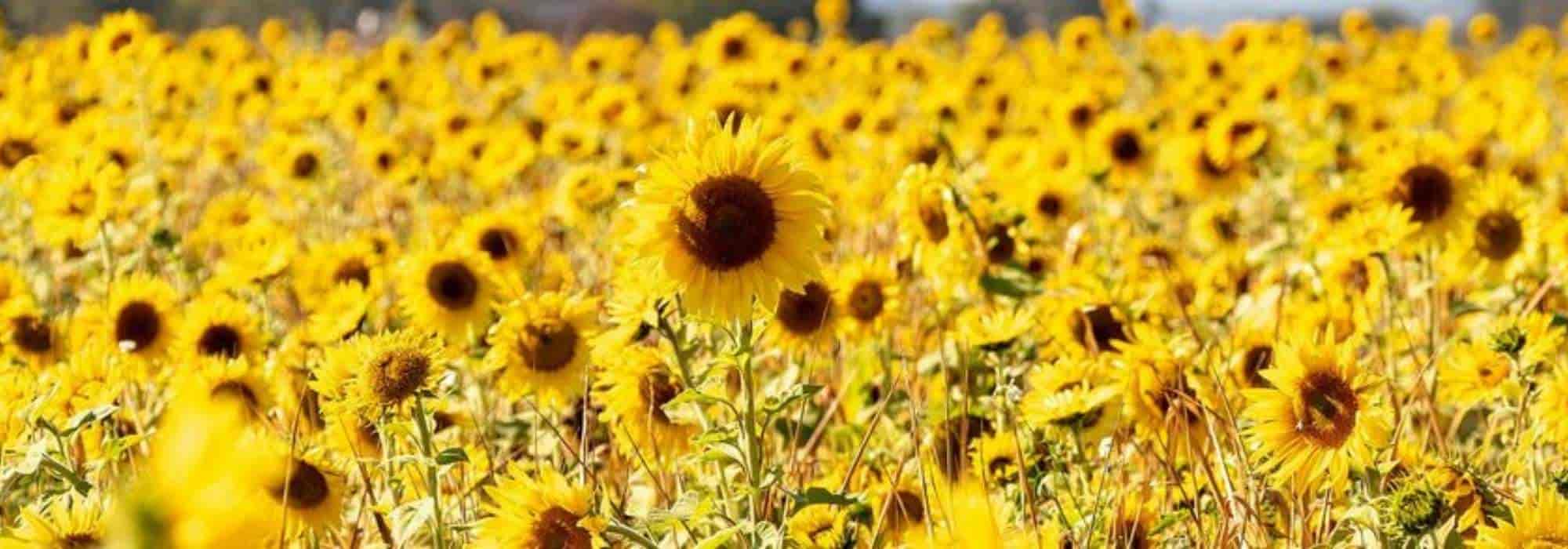

Sunflower Van Gogh Mix F1 seeds - Helianthus annuus
Sunflower Van Gogh Mix F1 seeds - Helianthus annuus
Helianthus annuus Van Gogh Mix F1
Sunflower, common sunflower
Special offer!
Receive a €20 voucher for any order over €90 (excluding delivery costs, credit notes, and plastic-free options)!
1- Add your favorite plants to your cart.
2- Once you have reached €90, confirm your order (you can even choose the delivery date!).
3- As soon as your order is shipped, you will receive an email containing your voucher code, valid for 3 months (90 days).
Your voucher is unique and can only be used once, for any order with a minimum value of €20, excluding delivery costs.
Can be combined with other current offers, non-divisible and non-refundable.
Home or relay delivery (depending on size and destination)
Schedule delivery date,
and select date in basket
This plant carries a 6 months recovery warranty
More information
We guarantee the quality of our plants for a full growing cycle, and will replace at our expense any plant that fails to recover under normal climatic and planting conditions.
Would this plant suit my garden?
Set up your Plantfit profile →
Description
The 'Van Gogh' Sunflower Mix provides flowers that are very diverse in terms of colours and shapes without having to buy several different packets. The tall plants offer single, semi-double or double flowers, showcasing all types and colours that can be found in Helianthus annuus. The colour range is exceptional, including cream yellow, lemon yellow, burgundy, orange, gold, bronze, and red. Easy to grow in full sun in any well-drained soil, these sunflowers attract butterflies and birds to the garden.
Helianthus annuus is none other than the famous sunflower cultivated on a large scale for the oil extracted from its seeds. This large annual plant from the Asteraceae family, domesticated by humans for a long time, has a controversial origin, but it is noted to be native to the American continent.
The 'Van Gogh Mix' F1 hybrid variety is a recent horticultural selection. It produces plants ranging in height from 1.5 to 2.1 m. The large flowers are single or double, measuring between 12 and 25 cm in diameter. Blooming from June to September, it showcases a palette of warm and bright colours, ranging from cream yellow to lemon yellow and orange, as well as deep shades of red and burgundy. The plants are vigorous and bushy. Each main stem produces numerous lateral branches, each carrying an inflorescence. Under optimal conditions, there is a 12-week period between sowing and the start of flowering. The foliage consists of medium green, simple, cordate (heart-shaped), alternate leaves, sometimes opposite at the base. They are attached to the stem by a long or short petiole and feel rough to the touch. The flowers are loved by pollinating insects and are followed by seeds that are eaten by birds and some small mammals.
The 'Van Gogh Mix' Sunflowers thrive in a large bed, in sunny and well-drained, not too dry soil. Their tall stature is good for planting towards the back of a flower bed, but they can also be used to create a seasonal hedge. Easy to sow and grow, ideal for introducing children to gardening. Although annual, it is a structural plant, at home in countryside gardens or wilder areas of the garden. You can pair it with tall grasses like Miscanthus sinensis 'Red Chief', giant thistle Eryngium giganteum 'Miss Willmott's Ghost', and Verbena bonariensis, for example. Create beautiful bouquets for the home with the diverse blooms of this sunflower.
Before blooming, the plant optimises its growth by following the sun's path. This phenomenon, called heliotropism, has given rise to some of its common names: Heliotrope, Sunflower, Garden Sun...
Sunflower in the kitchen: The buds, petals, and seeds are edible. Add some petals to a green salad for colour contrast and their nutty flavour. Green buds can be blanched, then sautéed in garlic butter. Their flavour is similar to that of Jerusalem artichokes. The seed kernel can be eaten raw or roasted.
An ecological asset: Throughout summer, the honey-producing flowers of Sunflowers attract pollinating insects and butterflies to your garden. A great way to enhance the ecosystem and promote fruit and vegetable production.
The oil-rich seeds are particularly appreciated by birds (Parrots, Tits, Doves, Goldfinches, Siskins, Nuthatches, Finches...). After flowering, harvest them for the birds during the winter scarcity period.
Flowering
Foliage
Plant habit
Botanical data
Helianthus
annuus
Van Gogh Mix F1
Asteraceae
Sunflower, common sunflower
Cultivar or hybrid
Other Sunflower seeds
View all →Planting and care
Sow the 'Van Gogh Mix' F1 sunflower seeds from March to May in pots. Use good quality soil sieved on the surface to bind the seed to its substrate. Before sowing, lightly tamp down the soil with a plank. Place 2 seeds 10 cm apart in each pot. Cover the seeds by sprinkling soil on top or vermiculite, lightly tamp down and water generously with a fine rain. Place your pots in the light, without direct sunlight, at a temperature of 20 °C to 25 °C. Lower the temperature at night to 17 °C to create a beneficial alternation for germination.
Seed germination will take about 21 days. Keep the soil moist, but not excessively during growth. 15 days before their final placement, start acclimatising them gradually to a temperature of 15 °C.
By late May or early June, the temperature will be warm enough in the garden to plant out your young plants. Choose a sunny location. Add a good shovelful of compost to each planting hole. Space your plants 45 cm apart.
Seeds can be sown directly in place in May. By staggering your sowings, you can extend flowering until autumn.
Protect your seedlings from attacks by snails and slugs that are fond of these young plants. Sowing chives near your sunflowers can deter aphids that might be tempted to settle there.
Sowing period
Intended location
Planting & care advice
This item has not been reviewed yet - be the first to leave a review about it.
Similar products
Haven't found what you were looking for?
Hardiness is the lowest winter temperature a plant can endure without suffering serious damage or even dying. However, hardiness is affected by location (a sheltered area, such as a patio), protection (winter cover) and soil type (hardiness is improved by well-drained soil).

Photo Sharing Terms & Conditions
In order to encourage gardeners to interact and share their experiences, Promesse de fleurs offers various media enabling content to be uploaded onto its Site - in particular via the ‘Photo sharing’ module.
The User agrees to refrain from:
- Posting any content that is illegal, prejudicial, insulting, racist, inciteful to hatred, revisionist, contrary to public decency, that infringes on privacy or on the privacy rights of third parties, in particular the publicity rights of persons and goods, intellectual property rights, or the right to privacy.
- Submitting content on behalf of a third party;
- Impersonate the identity of a third party and/or publish any personal information about a third party;
In general, the User undertakes to refrain from any unethical behaviour.
All Content (in particular text, comments, files, images, photos, videos, creative works, etc.), which may be subject to property or intellectual property rights, image or other private rights, shall remain the property of the User, subject to the limited rights granted by the terms of the licence granted by Promesse de fleurs as stated below. Users are at liberty to publish or not to publish such Content on the Site, notably via the ‘Photo Sharing’ facility, and accept that this Content shall be made public and freely accessible, notably on the Internet.
Users further acknowledge, undertake to have ,and guarantee that they hold all necessary rights and permissions to publish such material on the Site, in particular with regard to the legislation in force pertaining to any privacy, property, intellectual property, image, or contractual rights, or rights of any other nature. By publishing such Content on the Site, Users acknowledge accepting full liability as publishers of the Content within the meaning of the law, and grant Promesse de fleurs, free of charge, an inclusive, worldwide licence for the said Content for the entire duration of its publication, including all reproduction, representation, up/downloading, displaying, performing, transmission, and storage rights.
Users also grant permission for their name to be linked to the Content and accept that this link may not always be made available.
By engaging in posting material, Users consent to their Content becoming automatically accessible on the Internet, in particular on other sites and/or blogs and/or web pages of the Promesse de fleurs site, including in particular social pages and the Promesse de fleurs catalogue.
Users may secure the removal of entrusted content free of charge by issuing a simple request via our contact form.
The flowering period indicated on our website applies to countries and regions located in USDA zone 8 (France, the United Kingdom, Ireland, the Netherlands, etc.)
It will vary according to where you live:
- In zones 9 to 10 (Italy, Spain, Greece, etc.), flowering will occur about 2 to 4 weeks earlier.
- In zones 6 to 7 (Germany, Poland, Slovenia, and lower mountainous regions), flowering will be delayed by 2 to 3 weeks.
- In zone 5 (Central Europe, Scandinavia), blooming will be delayed by 3 to 5 weeks.
In temperate climates, pruning of spring-flowering shrubs (forsythia, spireas, etc.) should be done just after flowering.
Pruning of summer-flowering shrubs (Indian Lilac, Perovskia, etc.) can be done in winter or spring.
In cold regions as well as with frost-sensitive plants, avoid pruning too early when severe frosts may still occur.
The planting period indicated on our website applies to countries and regions located in USDA zone 8 (France, United Kingdom, Ireland, Netherlands).
It will vary according to where you live:
- In Mediterranean zones (Marseille, Madrid, Milan, etc.), autumn and winter are the best planting periods.
- In continental zones (Strasbourg, Munich, Vienna, etc.), delay planting by 2 to 3 weeks in spring and bring it forward by 2 to 4 weeks in autumn.
- In mountainous regions (the Alps, Pyrenees, Carpathians, etc.), it is best to plant in late spring (May-June) or late summer (August-September).
The harvesting period indicated on our website applies to countries and regions in USDA zone 8 (France, England, Ireland, the Netherlands).
In colder areas (Scandinavia, Poland, Austria...) fruit and vegetable harvests are likely to be delayed by 3-4 weeks.
In warmer areas (Italy, Spain, Greece, etc.), harvesting will probably take place earlier, depending on weather conditions.
The sowing periods indicated on our website apply to countries and regions within USDA Zone 8 (France, UK, Ireland, Netherlands).
In colder areas (Scandinavia, Poland, Austria...), delay any outdoor sowing by 3-4 weeks, or sow under glass.
In warmer climes (Italy, Spain, Greece, etc.), bring outdoor sowing forward by a few weeks.


























































